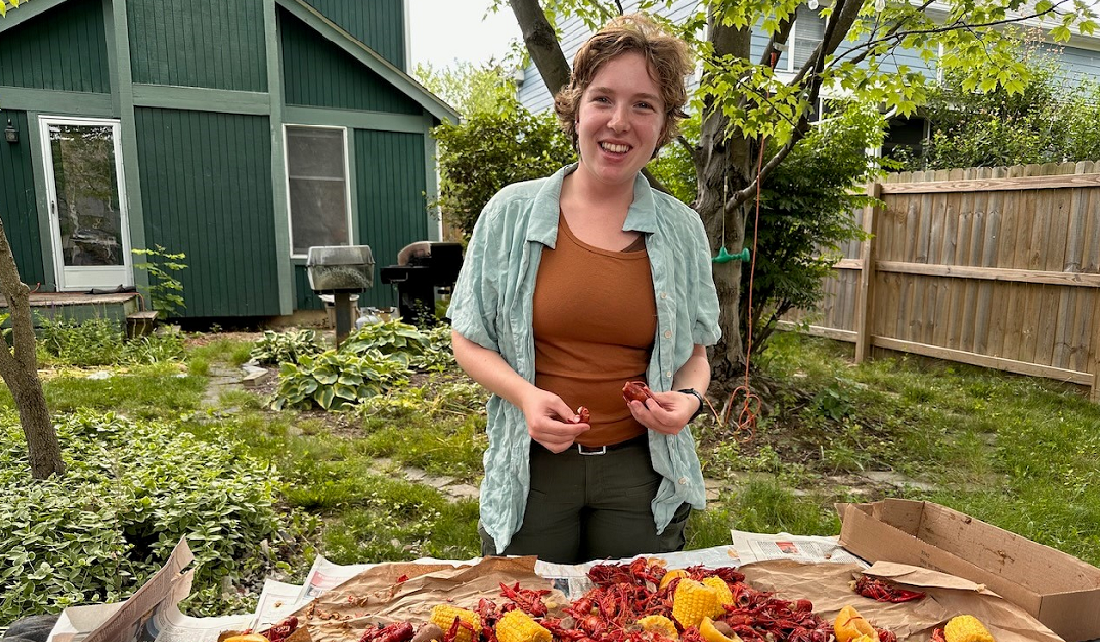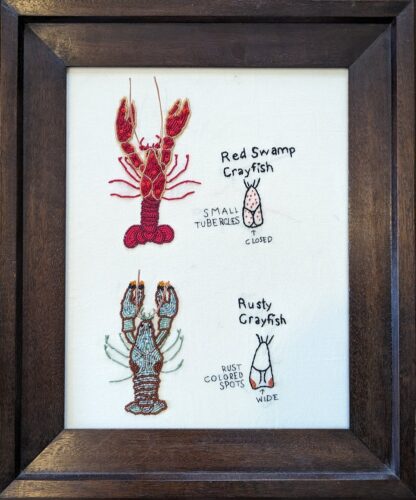
Meet Our Grad Student Scholars is a series from Illinois-Indiana Sea Grant (IISG) celebrating the students and research funded by our scholars program. To learn more about our faculty and graduate student funding opportunities, visit Fellowships & Scholarships.
Izzy Paulsen is a master’s student in the Department of Forestry and Natural Resources at Purdue University. She works in Purdue’s Coastal and Great Lakes Social Science Lab to study introduction pathways of invasive species. Paulson is investigating how invasive crayfish may be introduced to our waterways through schools and the culinary market and aims to learn what outreach professionals need to know to prevent future introductions.
 A trend I’ve observed from my time studying in school and working in the environmental field is that many people begin their journeys by wanting to work outside with nature. This may take many forms – measuring a tree, bird banding, conducting fish surveys, etc. While we expect some paperwork and computer time, some may be surprised by how common and necessary it is to communicate and collaborate with people outside this line of work. For me, this human connection is precisely why I chose this path: to work with others in caring for our natural resources.
A trend I’ve observed from my time studying in school and working in the environmental field is that many people begin their journeys by wanting to work outside with nature. This may take many forms – measuring a tree, bird banding, conducting fish surveys, etc. While we expect some paperwork and computer time, some may be surprised by how common and necessary it is to communicate and collaborate with people outside this line of work. For me, this human connection is precisely why I chose this path: to work with others in caring for our natural resources.
I began my undergraduate studies in archaeology, focusing on past human history and culture through the materials left behind. Over time, I increasingly focused on learning and participating in research about past human-environmental interactions, particularly foodways. I absolutely loved these opportunities, but there was a little part of me that felt like I could personally have more of an impact if I shifted my energies to the present. And so, with the “save the world” energy of a 20-year-old, I did. I added an environmental studies major and then got a job for an environmental conservation nonprofit. I am now in the second year of my master’s program in the Department of Forestry and Natural Resources at Purdue University, studying social sciences.
Despite the department I am in, I don’t do much work directly with our natural resources. Instead, my focus is on humans. My research investigates two introduction pathways for invasive crayfish in the Great Lakes states.
Invasive species are non-native beings that do environmental or economic harm, or harm to human health. Invasive crayfish can outcompete and displace native species and alter freshwater habitats. Another key aspect of invasive species is that their geographic range expands because humans transport them somehow, whether intentional or accidental. I am looking at how invasive crayfish are introduced via two specific pathways: classrooms and culinary practices.
The first introduction pathway I am exploring is teachers who use live crayfish in schools. Science teachers use crayfish to teach their students about animal behavior, genetics, anatomy, and more. However, several species of crayfish commonly used in classrooms, like red swamp crayfish (Procambrus clarkii) and rusty crayfish (Faxonius rusticus), may be invasive in certain regions. Many teachers may lack training on invasive species and may unknowingly contribute to their spread. My research explores why teachers use crayfish, how they manage them, and what happens to the crayfish afterward.

Izzy Paulsen’s art explores different ways to communicate about invasive species such as red swamp crayfish and rusty crayfish.
The second introduction pathway considers how live crayfish are used for food, like a crawfish boil. Red swamp crayfish, native to regions like Louisiana, are the most abundant species used for this dish and are a part of this cultural tradition.
A wonderful part of culture is that it can travel just as people do and with a more connected world, this is often easy. And so, when someone in a place like Indiana wants to have a crawfish boil, all they need to do is order a shipment off the internet or go to a grocery store or restaurant. This dish and cuisine have traveled and so have the crayfish that are now in new regions where they are considered invasive and can be harmful if they get into the waterways.
Through interviews and surveys, I aim to better understand these pathways.
This research will be shared with outreach professionals across the region and the country to guide the development of strategies, materials, and training programs that promote safe behaviors when handling live crayfish. By encouraging responsible practices, the hope is to prevent future introductions of invasive species.
Changing what people do is complex; simply providing information does not always work. I am trying to understand the whats and whys of people’s actions so that we can suggest alternatives that align with their goals and protect the resources that we value. It is said that an ounce of prevention is worth a pound of cure. The only way to prevent future invasive species is to collaborate with people and I believe it is well worth it because we might not see the results.
Working to prevent harm may involve more computer time than my days in archaeology. Addressing human behavior is infinitely complex. Yet, I’m driven by the belief that by connecting with people and fostering change, these efforts can make a meaningful difference.
_________________________________________________________
Illinois-Indiana Sea Grant is one of 34 Sea Grant programs supported by the National Oceanic and Atmospheric Administration in coastal and Great Lakes states that encourage the wise stewardship of our marine resources through research, education, outreach and technology transfer. In partnership with the University of Illinois Extension, and Purdue University Forestry and Natural Resources, Illinois-Indiana Sea Grant brings science together with communities for solutions that work.

